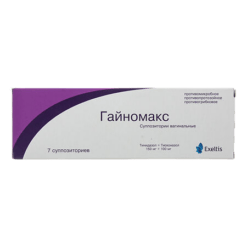No products in the cart.
Logest, 75 mcg+20 mcg 63 pcs
€64.07 €53.39
EAN: 4029668001316
SKU: 207420
Categories: Contraceptive, Gynecology and Obstetrics, Hormonal, Medicine
Description
LOGEST prevents ovulation by suppressing pituitary hormones and follicle development.
The thickening of cervical mucus prevents spermatozoa penetration into the uterus.
The drug normalizes the menstrual cycle, reducing pain and bleeding.
Indications
Indications
Contraception.
Pharmacological effect
Pharmacological effect
LOGEST prevents ovulation by suppressing pituitary hormones and follicular development.
Thickening of the cervical mucus prevents sperm from entering the uterus.
The drug normalizes the menstrual cycle, reducing pain and bleeding.
Special instructions
Special instructions
In case of planned surgery, it is recommended to stop taking the drug at least 4 weeks before the operation and not to resume taking it for 2 weeks after the end of immobilization.
While taking medications that affect microsomal enzymes, and for 28 days after their discontinuation, you should additionally use a barrier method of contraception.
While taking antibiotics such as ampicillins and tetracyclines and for 7 days after their discontinuation, you should additionally use a barrier method of contraception.
If the period of use of the barrier method of protection ends later than the tablet in the package, you need to move on to the next package of Logest® without the usual break in taking the tablet.
If any of the conditions/risk factors listed below currently exist, the potential risks and expected benefits of Logest® treatment should be carefully weighed in each individual case and discussed with the woman before she decides to start taking the drug. If any of these conditions or risk factors worsen, intensify, or appear for the first time, a woman should consult her doctor, who may decide whether to discontinue the drug.
Diseases of the cardiovascular system
There is evidence of an increased incidence of venous and arterial thrombosis and thromboembolism when taking combined oral contraceptives.
However, the incidence of venous thromboembolism occurring with combined oral contraceptives is less than that associated with pregnancy (6 per 10,000 pregnant women per year).
In women taking combined oral contraceptives, extremely rare cases of thrombosis of other blood vessels, such as the hepatic, mesenteric, renal arteries and veins, the central retinal vein and its branches, have been described. The connection with the use of combined oral contraceptives has not been proven.
A woman should stop taking the drug and consult a doctor if symptoms of venous or arterial thrombosis or cerebrovascular disorders develop, which may include: unilateral leg pain and/or swelling; sudden severe chest pain with or without radiating to the left arm; sudden shortness of breath; sudden attack of cough; any unusual, severe, prolonged headache; sudden partial or complete loss of vision; diplopia; slurred speech or aphasia; dizziness; loss of consciousness with/or without a seizure; weakness or very significant loss of sensation that suddenly appears on one side or in one part of the body; movement disorders; symptoms of “acute abdomen”.
The risk of thrombosis (venous and/or arterial) and thromboembolism increases:
– with age;
– in smokers (with an increase in the number of cigarettes or an increase in age, the risk further increases, especially in women over 35 years of age);
if available:
– family history (i.e. venous or arterial thromboembolism ever in close relatives or parents at a relatively young age); in case of hereditary predisposition, the woman should be examined by an appropriate specialist to decide on the possibility of taking combined oral contraceptives;
– obesity (body mass index more than 30 kg/m2);
– dislipoproteinemia;
– arterial hypertension;
– migraine;
– diseases of the heart valves;
– atrial fibrillation;
– prolonged immobilization, major surgery, any leg surgery or major trauma.
In these situations, it is advisable to stop using combined oral contraceptives (in the case of planned surgery, at least 4 weeks before it) and not to resume use for 2 weeks after the end of immobilization.
The increased risk of thromboembolism in the postpartum period should be taken into account.
Circulatory abnormalities may also occur in diabetes mellitus, systemic lupus erythematosus, hemolytic uremic syndrome, chronic inflammatory bowel disease (Crohn’s disease or ulcerative colitis) and sickle cell anemia.
An increase in the frequency and severity of migraines during the use of combined oral contraceptives (which may precede cerebrovascular events) may be grounds for immediate discontinuation of these drugs.
Biochemical parameters that may be indicative of hereditary or acquired susceptibility to venous or arterial thrombosis include resistance to activated protein C, hyperhomocysteinemia, antithrombin-III deficiency, protein C deficiency, protein S deficiency, and the presence of antiphospholipid antibodies (anticardiolipin antibodies, lupus anticoagulant).
Tumors
There are reports of an increased risk of developing cervical cancer with persistent human papillomavirus infection. Its connection with the use of combined oral contraceptives has not been proven. Controversy remains regarding the extent to which these findings relate to sexual behavior and barrier contraceptive use.
It was also found that there is a slightly increased relative risk of developing breast cancer diagnosed in women who used combined oral contraceptives. Its connection with the use of combined oral contraceptives has not been proven. The observed increased risk may be a consequence of earlier diagnosis of breast cancer in women using combined oral contraceptives.
In rare cases, the development of liver tumors has been observed during the use of combined oral contraceptives. The appearance of severe pain in the abdomen or signs of intra-abdominal bleeding, liver enlargement should be taken into account when making a differential diagnosis.
Other states
Women with hypertriglyceridemia (or a family history of this condition) may have an increased risk of developing pancreatitis while taking combined oral contraceptives.
Although slight increases in blood pressure have been described in many women taking combined oral contraceptives, clinically significant increases have rarely been reported. However, if a persistent, clinically significant increase in blood pressure develops while taking combined oral contraceptives, these drugs should be discontinued and treatment of arterial hypertension should be initiated. Taking combined oral contraceptives can be continued if normal blood pressure values are achieved with antihypertensive therapy.
The following conditions have been reported to develop or worsen both during pregnancy and while taking combined oral contraceptives, but their relationship with taking combined oral contraceptives has not been proven: jaundice and/or pruritus associated with cholestasis; formation of gallstones; porphyria; systemic lupus erythematosus; hemolytic uremic syndrome; chorea; herpes during pregnancy; hearing loss associated with otosclerosis. Cases of Crohn’s disease and ulcerative colitis have also been described during the use of combined oral contraceptives.
Acute or chronic liver dysfunction may require discontinuation of combined oral contraceptives until liver function tests return to normal. Recurrent cholestatic jaundice, which develops for the first time during pregnancy or previous use of sex hormones, requires discontinuation of combined oral contraceptives.
Although combined oral contraceptives may have an effect on insulin resistance and glucose tolerance, there is no need to change the therapeutic regimen in diabetic patients using low-dose combined oral contraceptives (
Women prone to chloasma should avoid prolonged exposure to the sun and ultraviolet radiation while taking combined oral contraceptives.
Laboratory tests
Taking combined oral contraceptives may affect the results of some laboratory tests, including liver, kidney, thyroid, adrenal function, plasma transport protein levels, carbohydrate metabolism, coagulation and fibrinolysis parameters. Changes usually do not go beyond normal values.
Effect on the menstrual cycle
While taking combined oral contraceptives, irregular bleeding (spotting or breakthrough bleeding) may occur, especially during the first months of use. Therefore, any irregular bleeding should be assessed only after an adaptation period of approximately 3 cycles.
If irregular bleeding recurs or develops after previous regular cycles, careful evaluation should be performed to rule out malignancy or pregnancy.
Some women may not develop withdrawal bleeding during a break from taking the tablets. If combined oral contraceptives are taken as directed, the woman is unlikely to be pregnant. However, if combined oral contraceptives have not been taken regularly before, or if there are no 2 withdrawal bleedings in a row, pregnancy should be excluded before continuing to take the drug.
Medical examinations
Before starting to use the drug Logest®, a woman is recommended to undergo a thorough general medical and gynecological examination (including examination of the mammary glands and cytological examination of cervical mucus) and exclude pregnancy. In addition, disorders of the blood coagulation system should be excluded.
In case of long-term use, it is necessary to carry out control examinations, the frequency of which depends on the individual characteristics of the woman.
The woman should be warned that drugs such as Logest® do not protect against HIV infection (AIDS) and other sexually transmitted diseases!
There was no effect on the ability to drive a car or use machinery.
Active ingredient
Active ingredient
Gestodene, Ethinylestradiol
Composition
Composition
1 tablet contains:
active substances:
gestodene 0.075 mg,
ethinyl estradiol 0.02 mg,
excipients:
lactose monohydrate – 37.155 mg;
corn starch – 15.5 mg;
povidone 25000 – 1.7 mg;
magnesium stearate – 0.55 mg,
shell:
sucrose – 19.66 mg;
povidone 700000 – 0.171 mg;
macrogol 6000 – 2.18 mg;
calcium carbonate – 8.697 mg;
talc – 4.242 mg;
mountain glycolic wax – 0.05 mg
Pregnancy
Pregnancy
Logest® is not prescribed during pregnancy and breastfeeding. If pregnancy is detected while taking Logest®, the drug is immediately discontinued.
However, extensive epidemiological studies have not shown any increased risk of developmental defects in children born to women who received sex hormones before pregnancy, or teratogenicity when sex hormones were inadvertently taken in early pregnancy.
Taking combined oral contraceptives can reduce the amount of breast milk and change its composition, so their use is contraindicated during lactation.
Small amounts of sex steroids and/or their metabolites can be excreted in milk, but there is no evidence of their negative effects on the health of the newborn.
Contraindications
Contraindications
Logest® should not be used if any of the conditions listed below are present. If any of these conditions develop for the first time while taking the drug, the drug should be discontinued immediately.
Thrombosis (venous and arterial) and thromboembolism currently or in history (including deep vein thrombosis, pulmonary embolism, myocardial infarction, cerebrovascular disorders).
Conditions preceding thrombosis (including transient ischemic attacks, angina), currently or in history.
History of migraine with focal neurological symptoms.
Diabetes mellitus with vascular complications.
Multiple or severe risk factors for venous or arterial thrombosis, incl. damage to the valvular apparatus of the heart, heart rhythm disturbances, diseases of the cerebral vessels or coronary arteries of the heart; uncontrolled arterial hypertension.
Pancreatitis with severe hypertriglyceridemia, currently or in history.
Liver failure and severe liver disease (until liver tests return to normal).
Liver tumors (benign or malignant) currently or in history.
Identified hormone-dependent malignant diseases (including genital organs or mammary glands) or suspicion of them.
Vaginal bleeding of unknown origin.
Pregnancy or suspicion of it.
Breastfeeding period.
Hypersensitivity to any of the components of the drug Logest®.
Prolonged immobilization, major surgery, leg surgery, major injuries.
WITH CAUTION
Severe disorders of fat metabolism (obesity, hyperlipidemia); thrombophlebitis of superficial veins; otosclerosis with hearing impairment, idiopathic jaundice or itching during a previous pregnancy; migraine; congenital hyperbilirubinemia (Gilbert, Dubin-Johnson and Rotor syndromes); diabetes mellitus; systemic lupus erythematosus; hemolytic uremic syndrome; Crohn’s disease; sickle cell anemia; arterial hypertension.
Side Effects
Side Effects
In rare cases, there may be tenderness and tightness of the mammary glands, enlarged mammary glands, discharge from the mammary glands, spotting and breakthrough uterine bleeding, headache, migraine, changes in libido, decreased/changes in mood, poor tolerance of contact lenses, blurred vision, nausea, vomiting, abdominal pain, changes in vaginal secretion, skin rash, erythema nodosum, multiforme erythema, generalized itching, cholestatic jaundice, fluid retention, changes in body weight, allergic reactions; rarely – increased fatigue, diarrhea; sometimes – chloasma, especially in women with a history of chloasma during pregnancy.
As with other combined oral contraceptives, in rare cases the development of thrombosis and thromboembolism is possible.
Interaction
Interaction
Sulfonamides and pyrazolone derivatives can enhance the metabolism of the steroid hormones included in the drug.
Long-term treatment with drugs that induce liver enzymes, which increases the clearance of sex hormones, may lead to breakthrough bleeding and/or a decrease in the contraceptive effectiveness of Logest®. These drugs include: phenytoin, barbiturates, primidone, carbamazepine and rifampicin; There are also suggestions for oxcarbazepine, topiramate, felbamate, ritonavir and griseofulvin and products containing St. John’s wort.
Contraceptive protection is reduced when taking antibiotics such as ampicillins and tetracyclines, because, according to some data, they can reduce the intrahepatic circulation of estrogens, thereby reducing the concentration of ethinyl estradiol.
Oral combined contraceptives may affect the metabolism of other drugs (including cyclosporine), which leads to changes in their concentration in plasma and tissues.
When taking estrogen-progestin drugs, adjustment of the dosage regimen of hypoglycemic drugs and indirect anticoagulants may be required.
Overdose
Overdose
Symptoms: nausea, vomiting, spotting or metrorrhagia.
Treatment: symptomatic. There is no specific antidote.
Storage conditions
Storage conditions
In a place protected from light, at a temperature not exceeding 25 °C.
Shelf life
Shelf life
3 years.
Manufacturer
Manufacturer
Bayer Bitterfeld GmbH, Germany
Additional information
| Shelf life | 3 years. |
|---|---|
| Conditions of storage | In a light-protected place at a temperature not exceeding 25 °C. |
| Manufacturer | Bayer Bitterfeld GmbH, Germany |
| Medication form | pills |
| Brand | Bayer Bitterfeld GmbH |
Related products
Gynecology and Obstetrics
Buy Logest, 75 mcg+20 mcg 63 pcs with delivery to USA, UK, Europe and over 120 other countries.




















